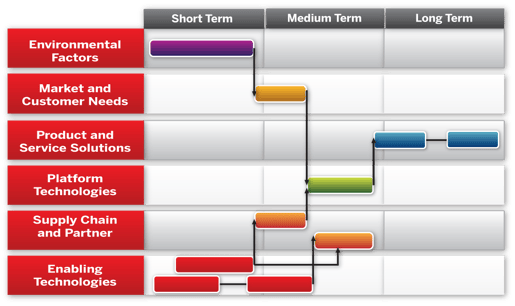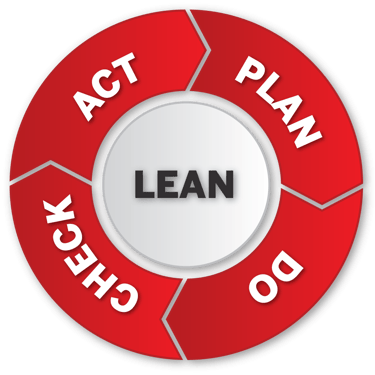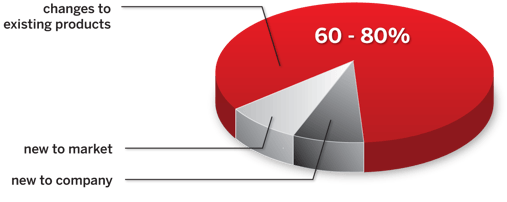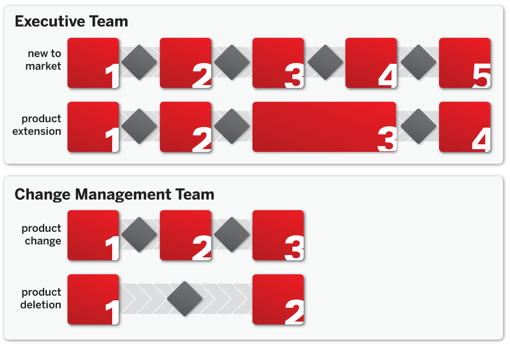The pendulum has swung toward Lean and Agile methodologies, sometimes casting Stage-Gate ® aside. Optimal results are derived from the best of BOTH worlds as part of an integrated best practice innovation toolkit.
Effective Innovation Management
There are two primary goals of effective innovation management:
- Doing the Right Things, and
- Doing things Right
Effective Integration Between Business and Innovation Strategy
This defines strategic arenas of innovation opportunity, or focus, which matter significantly to your customers.Effective Long Range Strategic Roadmapping
Inform the business, innovation and technology strategies on multiple dimensions:
Effective “Voice of the Customer” and Consumer Insight Methods
Ensure the alignment of new products and services with un-met customer needs.Effective Portfolio Management Methods
These establish and monitor the relative innovation investments in each strategic arena – your portfolio imperatives.Effective Ideation Methods
Capture and define product and service opportunities within each strategic arena and evaluate and prioritize these against portfolio objectives.
Ready to start capturing ideas now? Schedule a demo of our Acclaim Ideas offering:
Effective Stage-Gate® Methods
Apply the Go/Kill/Hold/Recycle decisions to prioritize your investments in the innovation funnel.
Effectively applied, Stage-Gate® is where the “rubber meets the road” – it is where strategy is made real by approving, resourcing and accelerating projects which enhance strategic priorities AND also by killing, or de-prioritizing weaker projects.
Through effective gate keeping, Stage-Gate® processes enable the decision making required to “Do the Right Things.”
Stage-Gate® also supports “Doing things Right” by providing guidance, checklists, templates and examples of the work required within each stage.
Ready to automate your gated processes with best practices? Schedule some time to speak with one of our innovation management experts:
SPIRAL Development
The greatest variance between an “agile” methodology and “gated” innovation management relates to the development of product and service specifications. Traditional gate-based development methods advocate the creation of a “detailed product charter” OR “integrated product definition.” The emphasis in this approach is on the clear and full definition of the product BEFORE development begins.
In the agile world, emphasis shifts toward the high level definition of the “what” and “why” dimensions of the product specification, rather than the “how.” Iterative, fast-paced development explores the best methods of the “how” to best deliver the desired functionality and “how” to best meet the customer need. Frequent, iterative consultation with the customer is used to ensure alignment of the developed solution with the customer needs.
A key advantage of spiral development methods, including agile, is that the iterative development process is well suited to areas of increased uncertainty, higher technical risk and more complex development projects.
LEAN Product Development
Lean is both a philosophical and a tactical approach to Product and Service Innovation.
At its core, lean has two primary objectives:
- Maximizing Value
- Minimizing Waste
Too often, the very word “lean” conjures up a frugal mindset focused only on cost reduction and waste minimization. This is also partially attributable to its origins in Lean Manufacturing where improvements in cost, efficiency and speed are paramount.
In practice, lean product development is mostly applied at a tactical level and in conjunction with the Stage-Gate methodology applies primarily to the way development work is completed within each stage.
The origins of lean in the context of product development are founded in studies of Toyota's product development systems which delivered dramatic improvements over the methods used by their traditional competitors. Rather than a detailed step-by-step process, they have a simple project plan which identifies key dates and responsibilities. In contrast with some American competitors, Toyota's development methods deliver vehicles with:
- Higher quality levels
- Four times the productivity per engineer
- Half the development time
- More innovation and reduced risk
Toyota applies tremendous rigor to how they capture learning, they study BOTH what works and doesn't work. They document it fastidiously and disseminate it broadly.
This practice of reviewing past projects to capture the determinants of success and failure is a key to the success of the Toyota system. At the beginning of the project Toyota do not set tight specifications but rather move from the broad to the specific as they progress through their development.
Adoption of methods from the software world have seen the emergence of “agile”, or "scrum,” as a methodologies for iterative development, aligned with the “Plan – Do – Check – Act” cycle developed by Walter Shewhart and popularized by Demming.

According to Lean development expert, Don Reinertsen — using lean methods in product development requires insight as to which management practices impede the flow. Success in lean product development requires:
- Understanding the cost of delay
- Managing variability and queues
- Reducing batch size
- Controlling flow
- Accelerating feedback
- Decentralizing control
- Finding waste
If we expand our Lean thinking from the Tactical to the philosophical, we can look at the way in which we implement Stage-Gate seeks to achieve Lean outcomes.
Making Stage-Gate Lean
One of the common mistakes in Stage-Gate implementation is to blindly adopt the 5 stage process for all businesses and for all projects. Processes need to be aligned to the level of risks in projects and while new to world or new to company projects may require the rigor of a 5-stage process, this is not always the case.

Many companies, who adapt products for local markets or pursue a market follower rather than a product leadership position, require at most a 4-stage process model.


This balance makes absolute business sense for most companies since the re-investment in existing products is required to extend their market life – keeping the cash cows alive for longer.
Product change and product deletion processes require a simplified Stage-Gate process with a reduced number of stages and gates.

In keeping Stage-Gate lean it is critical to establish discrete process models aligned with project risk and also to establish tiered responsibilities of gate keepers so that the decision making responsibilities are aligned with the level of business risk.

The Best of Both Worlds
A common goal of both lean product development and effective Stage-Gate management is to kill weak projects and to divert resources to stronger projects, maximizing the value of the innovation pipeline.
Researchers Boehm and Turner have identified that: “Future projects will need BOTH agility and discipline, which can be implemented by containing the agile development model within the gate model."
In seeking the “Best of Both Worlds,” Karlstrom and Runeson have identified key issues for more effective development methods involving Agile methods including:
- Involving developers early in the product development
- Adapting the project planning to accommodate for agile micro planning in combination with macro project planning
- Identifying critical feedback loops and make these as short and fast as possible
- Striving to make an early version of the actual product as quickly as possible using technical tools for technical coordination
- Making the customer-developer roles and interactions as clear end effective as possible
- Working chiefly with management attitudes to accommodate uncertainties
Summary
In summary, there are benefits of integrating agile thinking into traditional Stage-Gate models. Key issues must be addressed to derive the key strengths from both processes. The biggest mistake is to focus on which tool is best rather than on when to use each tool and in what combinations to optimize business outcomes.
Stage-Gate is a registered trademark of Stage-Gate Inc. All other trademarks are the sole property of their respective owners.
Reference List: 1. Karlstrom, D. and Runeson, Per. (2005) Integrating Agile Software Development into Stage-Gate Managed Product Development.







